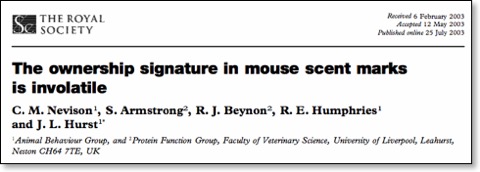Involatile ownership signals in mouse scent marks

Nevison, C.M., Armstrong, S.; Beynon, R.J. Humphries, R.E. & Hurst, J.L. (2003) The ownership signature in mouse scents marks is involatile. Proceedings of the Royal Society series B, 270, 1957-1963 [PUBMED] [PDF]
Male house mice advertise their territory ownership through urinary scent marks and use individual-specific patterns of major urinary proteins (MUPs) to discriminate between their own scent and that of other males. It is not clear whether recognition occurs through discrimination of the non-volatile proteins or protein-ligand complexes (direct model), or by the detection of volatile ligands that are released from MUPs (indirect model). To examine the mechanism underlying individual scent mark signatures, we compared investigatory and countermarking responses of male laboratory mice presented with male scent marks from a strain with a different MUP pattern, when they could contact the scent or when contact was prevented by a porous nitrocellulose sheet to which proteins bind. Mice investigated scent marks from other males whether these were covered or not, and biochemical analysis confirmed that the porous cover did not prevent the release of volatiles from scent marks. Having gained information through investigation, mice increased their own scent marking only if they had direct contact with another male's urine, failing to do this when contact was prevented. Individual signatures in scent marks thus appear to be carried by non-volatile proteins or by non-volatile protein-ligand complexes, rather than by volatiles emanating from the scent.